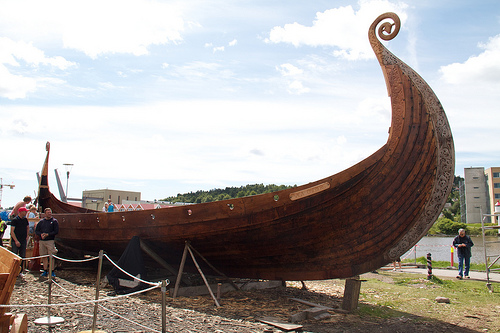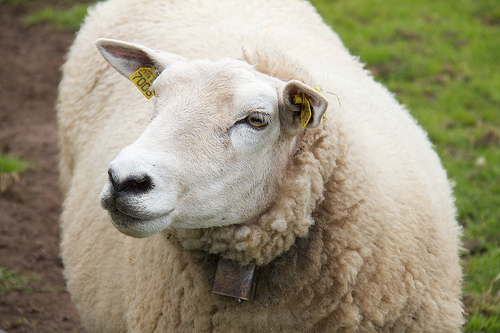
After Oslo we finally hooked up with my long-time friend Guro and her husband Preben and beautiful kids, Helene and Kyrre. This was my first time meeting the kids, and it had been nine years since I’d seen Guro and Preben, when they visited me in Canada.

We took the train to Tønsberg from just outside of Oslo, since the train station in Oslo was closed down for major track work. It was about a two hour ride, and we arrived mid-afternoon, so Guro took us out to Verdens Ende a scenic spattering of rocky islets that you can walk, scramble, climb and hop over for quite some distance. Guro’s daughter, Helene is known as the goat — nimble creature that she is, jumping from cliff to cliff. She also introduced me to the non-stinging “glass” jellyfish above (of course, she couldn’t tell me that it didn’t sting, speaking only Norwegian at eight years old, but I figured if she could hold it, so could I).

As I mentioned before, Guro lived with me as an exchange student while I was in grade 9 in high school. She had originally started her exchange with another host family, but that didn’t work out, and eventually she found us / we found her. My parents had been considering the idea of hosting a student, and then we found the ad in the paper that she was looking for a new family. When we met, it was like we’d known each other forever. And so began our twenty-year long friendship.

On our second day we walked into downtown Tønsberg where we saw the replica of the Oseberg Ship, the one originally found in a burial site near the town itself. A couple of years ago a group decided to try to rebuild the ship using the original hand techniques of the age, and apparently this past spring they sailed the ship, launching it right from where they had built it. The King and Queen were present, and the entire town came out for the occasion. That would have been so cool to see.


After a lunch of sushi we checked out Tønsberg Fortress, or what remains of it, on a hilltop at the edge of town. This model showcases the original layout of the site. This was the eastern home of King Håkon Håkonsson and his son King Magnus Lagabøte in the 1200’s (the same rulers who maintained Håkon’s Hall and Rosenkrantz Tower in Bergen, which we had toured earlier in our trip). There’s not much left to see but some of the old walls remain and many of the building foundations are still there. And the view of Tønsberg and the surrounding area, which we enjoyed in between smatterings of rain, is magnificent.

The next day Chris and I took the train from Tønsberg to Nærbø, near Stavanger, the farming community where Guro grew up, while she and her family drove. We arrived after about 6 hours and were greeted by her sister Maryann who took us to the dairy/cow/chicken/sheep farm where she lives with her partner Nils, while we awaited Guro, who was delayed due to traffic. It was a terrific opportunity to see a local farm in action. It seems that everyone in the region farms a variety of livestock, which is quite different from what I’m used to at home, where generally most farmers either grow cash crops, or a combination of cash crops and one type of livestock. Its not that common at home for you to come across a dairy farmer who also has a pig barn, for example, although I do know of some organic operations that farm more variety.
Nils had that preoccupied, worried look about him that farmers often get when their window of opportunity to get some key task done is getting slim, and he was concerned about getting the grass cut. The region we were in, Jæren, is the largest area of flat land in Norway, and as such, it’s the bread basket of the country. It’s here that a significant amount of the country’s food is grown, although its mostly livestock based agriculture. The grass that needed cutting is what will be used to make what we call here haylage (or silage), the fermented, high moister grass-based feed for ruminants (cattle and sheep). At home you often see it as big round bales that are wrapped with the wait plastic, or piled into a concrete holding area and wrapped with plastic that’s often held down with old tires. This is the primary food crop for the livestock farmers of the area, and getting it off at just the right time, with just the right weather conditions is critical. And to further complicate things, Nils was worried about various road work projects that were going to add extra travel time to and from his other farms. He had the extra cost calculated down to the last cent.

Jæren is also known for its fabulous beaches. The climate here is very mild, with the area getting very little snow and generally not getting below freezing temperatures. Winter consists mostly of rain, but because of the area’s flat terrain, wind is ever-present.


Lovely yellow climbing roses, planted by Guro’s late mother, growing at her Dad’s place.

Another feature of the region are the dry stone fences that line the landscape. There are still many fields speckled with giant rocks, dropped off by receding glaciers, and often they’re the ones left for the cattle and sheep to graze. The rocks that get cleared from the fields are piled into these very pretty fences.


We stayed here for a couple nights, during the last leg of our trip. On our second day in the area we drove to and hiked Preikestolen, but I’m going to put that up as its own post, because there are so many photos.


On our last day we checked out the Jærmuseet Vitengarden, for Farming Museum (one of a series of museums under the Jærmuseet umbrella), which was very cool. Lots of local traditional history and equipment. The kids love it there, and it was a lot of fun to explore. You can also walk all around the landscape there, right through the cattle pasture even, who couldn’t care less that you’re cutting through their space. I really enjoyed the access we had in the area actually — at home, most livestock barns are now heavily restricted areas, especially pig barns, and as an outsider you are not allowed to even go within a certain distance of these barns. It was much more open and easy going in Norway.


I didn’t get a chance to go riding on fjord horses, which I would have loved to do, but oh well. I’ve heard they aren’t exactly known for their comfy gait anyway (they are however known for their surefootedness on a mountainside). They were however offering little kids rides on them around the barnyard, so I supposed if I was about 25 years younger I could have given it a go!

We were also greeted by a very happy group of bell-clanging sheep, who came running towards us at the fence full blast. Cute!

In the above photo you can see Nils’s farm (with his grass cut!) which was directly across from the train tracks from the Jærmuseet. His parents live there too, in their own house. And in the background, lots of wind turbines to take advantage of the area’s breezy resources.

One more post to come. I know I’ve been veering from my regular blog content but I hope you, dear reader, have been enjoying these posts too. It’s a nice way for me to reminisce about the trip we took, which already feels like ages ago. It was a trip of a lifetime and I want to document the experience for myself as much as for anyone else interested in reading about it. Garden posts will come soon! But one more Norway post to come and then it’s back to our regular programing over here at digginthedirt.ca!
See all my images from Tønsberg & Jæren over at Flickr.
Thank you for your great posts re your trip to Norway – I’m a huge fan of your “regular programming”, but the Norway pictures and your descriptions are wonderful too; I was lucky enough to spend 2 weeks in Norway a few years ago, and adored it – your posts are a wonderful way to relive that happy trip. I joke with my husband all the time about moving to Stavanger one day – it was so beautiful, the climate is perfect, and as you note in your latest post, the diversity of livestock is fantastic.